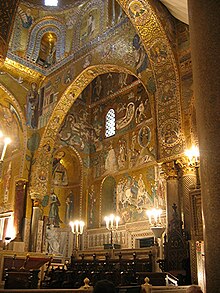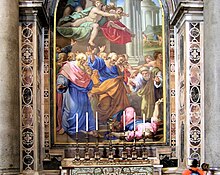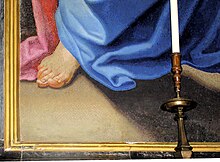
Pottery is the process and the products of forming vessels and other objects with clay and other raw materials, which are fired at high temperatures to give them a hard and durable form. The place where such wares are made by a potter is also called a pottery. The definition of pottery, used by the ASTM International, is "all fired ceramic wares that contain clay when formed, except technical, structural, and refractory products". End applications include tableware, decorative ware, sanitaryware, and in technology and industry such as electrical insulators and laboratory ware. In art history and archaeology, especially of ancient and prehistoric periods, pottery often means vessels only, and sculpted figurines of the same material are called terracottas.

Raku ware is a type of Japanese pottery traditionally used in Japanese tea ceremonies, most often in the form of chawan tea bowls. It is traditionally characterised by being hand-shaped rather than thrown, fairly porous vessels, which result from low firing temperatures, lead glazes and the removal of pieces from the kiln while still glowing hot. In the traditional Japanese process, the fired raku piece is removed from the hot kiln and is allowed to cool in the open air.

A mosaic is a pattern or image made of small regular or irregular pieces of colored stone, glass or ceramic, held in place by plaster/mortar, and covering a surface. Mosaics are often used as floor and wall decoration, and were particularly popular in the Ancient Roman world.

Terracotta, also known as terra cotta or terra-cotta, is a term used in some contexts for earthenware. That is to say it is a clay-based unglazed or glazed non-vitreous ceramic, fired at relatively low temperatures.

A tessellation or tiling is the covering of a surface, often a plane, using one or more geometric shapes, called tiles, with no overlaps and no gaps. In mathematics, tessellation can be generalized to higher dimensions and a variety of geometries.

Tiles are usually thin, square or rectangular coverings manufactured from hard-wearing material such as ceramic, stone, metal, baked clay, or even glass. They are generally fixed in place in an array to cover roofs, floors, walls, edges, or other objects such as tabletops. Alternatively, tile can sometimes refer to similar units made from lightweight materials such as perlite, wood, and mineral wool, typically used for wall and ceiling applications. In another sense, a tile is a construction tile or similar object, such as rectangular counters used in playing games. The word is derived from the French word tuile, which is, in turn, from the Latin word tegula, meaning a roof tile composed of fired clay.

Gilding is a decorative technique for applying a very thin coating of gold over solid surfaces such as metal, wood, porcelain, or stone. A gilded object is also described as "gilt". Where metal is gilded, the metal below was traditionally silver in the West, to make silver-gilt objects, but gilt-bronze is commonly used in China, and also called ormolu if it is Western. Methods of gilding include hand application and gluing, typically of gold leaf, chemical gilding, and electroplating, the last also called gold plating. Parcel-gilt objects are only gilded over part of their surfaces. This may mean that all of the inside, and none of the outside, of a chalice or similar vessel is gilded, or that patterns or images are made up by using a combination of gilt and ungilted areas.

Trencadís, also known as pique assiette, broken tile mosaics, bits and pieces, memoryware, and shardware, is a type of mosaic made from cemented-together tile shards and broken chinaware. Glazed china tends to be preferred, and glass is sometimes mixed in as well, as are other small materials like buttons and shells. Artists working in this form may create random designs, pictorial scenes, geometric patterns, or a hybrid of any of these.

Porcelain tiles or ceramic tiles are porcelain or ceramic tiles commonly used to cover floors and walls, with a water absorption rate of less than 0.5 percent. The clay used to build porcelain tiles is generally denser. They can either be glazed or unglazed. Porcelain tiles are one type of vitrified tiles and are sometimes referred to as porcelain vitrified tiles.
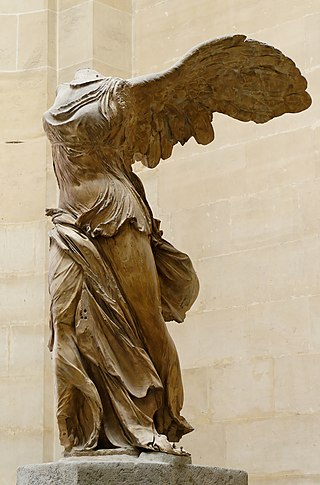
Hellenistic art is the art of the Hellenistic period generally taken to begin with the death of Alexander the Great in 323 BCE and end with the conquest of the Greek world by the Romans, a process well underway by 146 BCE, when the Greek mainland was taken, and essentially ending in 30 BCE with the conquest of Ptolemaic Egypt following the Battle of Actium. A number of the best-known works of Greek sculpture belong to this period, including Laocoön and His Sons, Venus de Milo, and the Winged Victory of Samothrace. It follows the period of Classical Greek art, while the succeeding Greco-Roman art was very largely a continuation of Hellenistic trends.

Ceramic glaze, or simply glaze, is a glassy coating on ceramics. It is used for decoration, to ensure the item is impermeable to liquids and to minimise the adherence of pollutants.

Glass tiles are pieces of glass formed into consistent shapes.
This is a list of pottery and ceramic terms.

Roman glass objects have been recovered across the Roman Empire in domestic, industrial and funerary contexts. Glass was used primarily for the production of vessels, although mosaic tiles and window glass were also produced. Roman glass production developed from Hellenistic technical traditions, initially concentrating on the production of intensely coloured cast glass vessels. However, during the 1st century AD the industry underwent rapid technical growth that saw the introduction of glass blowing and the dominance of colourless or 'aqua' glasses. Production of raw glass was undertaken in geographically separate locations to the working of glass into finished vessels, and by the end of the 1st century AD large scale manufacturing resulted in the establishment of glass as a commonly available material in the Roman world, and one which also had technically very difficult specialized types of luxury glass, which must have been very expensive.

Hellenistic glass was glass produced during the Hellenistic period, from the conquests of Alexander the Great to the expansion of the Roman Empire in the Mediterranean, Europe, western Asia and northern Africa. Glassmaking at this time was based on the technological traditions of the Classical antiquity and the Late Bronze Age, but was marked by transition from limited production of luxury objects made for the social elite to mass production of affordable glass vessels used by the broader public to satisfy everyday needs.

A Roman mosaic is a mosaic made during the Roman period, throughout the Roman Republic and later Empire. Mosaics were used in a variety of private and public buildings, on both floors and walls, though they competed with cheaper frescos for the latter. They were highly influenced by earlier and contemporary Hellenistic Greek mosaics, and often included famous figures from history and mythology, such as Alexander the Great in the Alexander Mosaic.
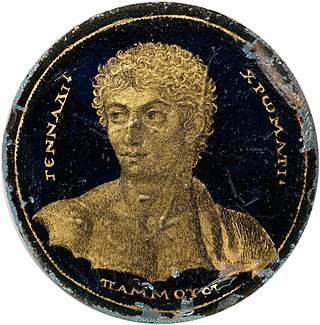
Gold glass or gold sandwich glass is a luxury form of glass where a decorative design in gold leaf is fused between two layers of glass. First found in Hellenistic Greece, it is especially characteristic of the Roman glass of the Late Empire in the 3rd and 4th century AD, where the gold decorated roundels of cups and other vessels were often cut out of the piece they had originally decorated and cemented to the walls of the catacombs of Rome as grave markers for the small recesses where bodies were buried. About 500 pieces of gold glass used in this way have been recovered. Complete vessels are far rarer. Many show religious imagery from Christianity, traditional Greco-Roman religion and its various cultic developments, and in a few examples Judaism. Others show portraits of their owners, and the finest are "among the most vivid portraits to survive from Early Christian times. They stare out at us with an extraordinary stern and melancholy intensity". From the 1st century AD the technique was also used for the gold colour in mosaics.

Ceramic art is art made from ceramic materials, including clay. It may take varied forms, including artistic pottery, including tableware, tiles, figurines and other sculpture. As one of the plastic arts, ceramic art is a visual art. While some ceramics are considered fine art, such as pottery or sculpture, most are considered to be decorative, industrial or applied art objects. Ceramic art can be created by one person or by a group, in a pottery or a ceramic factory with a group designing and manufacturing the artware.

The mosaics of Delos are a significant body of ancient Greek mosaic art. Most of the surviving mosaics from Delos, Greece, an island in the Cyclades, date to the last half of the 2nd century BC and early 1st century BC, during the Hellenistic period and beginning of the Roman period of Greece. Hellenistic mosaics were no longer produced after roughly 69 BC, due to warfare with the Kingdom of Pontus and the subsequently abrupt decline of the island's population and position as a major trading center. Among Hellenistic Greek archaeological sites, Delos contains one of the highest concentrations of surviving mosaic artworks. Approximately half of all surviving tessellated Greek mosaics from the Hellenistic period come from Delos.
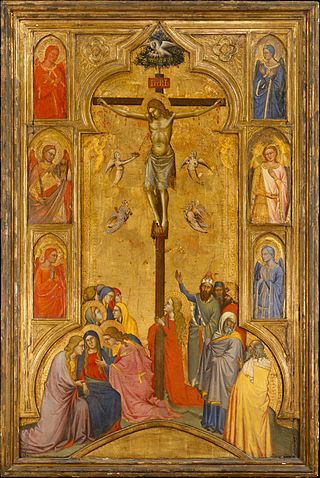
Gold ground or gold-ground (adjective) is a term in art history for a style of images with all or most of the background in a solid gold colour. Historically, real gold leaf has normally been used, giving a luxurious appearance. The style has been used in several periods and places, but is especially associated with Byzantine and medieval art in mosaic, illuminated manuscripts and panel paintings, where it was for many centuries the dominant style for some types of images, such as icons. For three-dimensional objects, the term is gilded or gold-plated.
